The Cornell Lab Bird Academy › Discussion Groups › Inspiring Investigations through Citizen Science › Encouraging Observations
-
Bird AcademyBird AcademyWhat was the most impactful thing about creating your sound map? How might you encourage the children you teach to use their senses to observe the natural world more fully? Share your thoughts in the comment box below, and add an image of your sound map by clicking the small “image” icon under the comment box.You must be enrolled in the course to reply to this topic.
-
 The most impactful thing when completing the sound map was how much I didn't realize all the sounds I was hearing. You initially think that only one or two sounds will be noticeable. When completing this activity with students, I would guide the students in completing a mental checklist (What do I hear? What do I smell? What do I taste? What do I see? What do I feel?). Lastly, I would also remind them to be patient!
The most impactful thing when completing the sound map was how much I didn't realize all the sounds I was hearing. You initially think that only one or two sounds will be noticeable. When completing this activity with students, I would guide the students in completing a mental checklist (What do I hear? What do I smell? What do I taste? What do I see? What do I feel?). Lastly, I would also remind them to be patient! -
 The most impactful part of creating my sound map was just sitting in silence and really relying on my sense of sound. At first it was hard to tell how far away the sound was coming, but after a few minutes, it became easier to decipher the distance. I have my students use sound maps and it does help them to really focus on the sense of sound. I also have them draw detailed pictures of an ephemeral flower. Then they have to try and match someone else's drawing to the actual flower. It encourages them to really draw a detailed picture using their observations. It is similar to the lemon activity.
The most impactful part of creating my sound map was just sitting in silence and really relying on my sense of sound. At first it was hard to tell how far away the sound was coming, but after a few minutes, it became easier to decipher the distance. I have my students use sound maps and it does help them to really focus on the sense of sound. I also have them draw detailed pictures of an ephemeral flower. Then they have to try and match someone else's drawing to the actual flower. It encourages them to really draw a detailed picture using their observations. It is similar to the lemon activity. -
 The most impactful thing for me when creating the sound map, was how much "man-made noise" I heard. For example, cars, bikes, planes, etc. I had hoped to hear more of not "man-made noise". It was cool to hear bird sounds as I hear them frequently where I live. When doing a sound map, I love closing my eyes to be fully immersed in the sound. I will encourage my students to do the same.
The most impactful thing for me when creating the sound map, was how much "man-made noise" I heard. For example, cars, bikes, planes, etc. I had hoped to hear more of not "man-made noise". It was cool to hear bird sounds as I hear them frequently where I live. When doing a sound map, I love closing my eyes to be fully immersed in the sound. I will encourage my students to do the same. -
So often sighted people--and particularly students--rely on sight as the primary sense. This sound map does a wonderful job of asking students to not just use all of their sense when making observations but forces them to focus on just one.
-
The most impactful thing about creating my sound map was the way that I was able to hear and focus on each individual sound without distraction. Typically if you are outside, you are hearing all of the sounds blended together. I can encourage my students to use their senses to observe the world more fully by helping them develop their observation skills. Using activities such as this can help students focus on using their senses for observation.

-
I found it interesting how much noise there was in the time I was doing this activity. There is construction happening so I knew there would be that noise but there was also a bunch of leaves moving, dogs barking and birds singing. It made me think about everything that is going on in a place that I spend a lot of my time.

-
Was very disappointing to hear so much man-made noise (mostly generalized traffic sounds). We are in a small town in Massachusetts, but near several larger roads/highways. Regardless, it was enjoyable to simply close my eyes and focus on the sounds for 10 minutes. I think this will be a very "ear-opening" experience for my students. We already reinforce the fact that observation is not only "seeing", but this activity will really solidify the power of hearing. I like the idea of comparing what students can observe by seeing vs. hearing.

-
Being aware of the sounds of nature around us helps us to realize that we are surrounded by biodiversity. Unfortunately, sounds such as traffic often drown out the more subtle tones of nature. I feel that this will be a great activity to conduct even at the high school level to make the students more aware of their surroundings.

-
It took me a moment to process which direction the sounds were coming from. First hearing them I thought they were in front of me, but after concentrating, I believe the sound of the frogs were coming from behind me, but maybe echoing of trees. I found myself turning my head a lot to help me focus.
-
 Lots of fun hearing stuff! I do this activity with several of my classes. The little ones we rotate their location 3 times, with 5 minutes at each station. After each station we see how many things they could identify and then move to another station. The more stations we go to the more sounds they notice. This hearing activity is a great way to get kids to explore nature thru all of their senses. One we all enjoy!
Lots of fun hearing stuff! I do this activity with several of my classes. The little ones we rotate their location 3 times, with 5 minutes at each station. After each station we see how many things they could identify and then move to another station. The more stations we go to the more sounds they notice. This hearing activity is a great way to get kids to explore nature thru all of their senses. One we all enjoy! -
Unfortunately it is very hot out where I live and in the middle of the city!! Yay Phoenix. But that doesn't mean I haven't done this in the past. In fact, in college we did a five senses mediation a lot for sense of place activities. You ask people to sit down and close their eyes and ask them to engage a different sense at different times. At this time of year one of the major senses is the smell of the monsoon rains! Which have just started, and a little early for this time of year! For the activity all I have is small yard with a bird feeder so must of the attention comes from that directly in front of me. Lots of birds! the other primary noise unfortunately comes from the main road in the front of the house.
-
When you actually sit down and become part of nature you begin to realize the vast amount of life that exists around you. In the late evening birds are very active in singing and communicating with one another, toads begin calling, crickets are chirping, mosquitoes, common nighthawks and bats begin to become active. The environment becomes alive. This would be a great project for students to get a taste of what nature has to offer, especially if you have a time of day or a location that would allow them to see and hear a multitude of organisms that are around them.

-
 It would be interesting and valuable to sit for a longer period of time and/or at different times of day to compare sounds. I know that during the day I may hear more human sounds like cars or mowers, and at night I would hear more frogs, toads, owls, and chuck-will's-widows. This activity could also be repeated throughout the year, since right now I'm hearing summer sounds of cicadas and the birds that stick around through the summer. In the spring and fall I may hear more variety of migrating birds. These are just the things I expect, but I'm sure if I'm paying close enough attention, I would encounter something unexpected that I never would have noticed without focusing on the sounds!
It would be interesting and valuable to sit for a longer period of time and/or at different times of day to compare sounds. I know that during the day I may hear more human sounds like cars or mowers, and at night I would hear more frogs, toads, owls, and chuck-will's-widows. This activity could also be repeated throughout the year, since right now I'm hearing summer sounds of cicadas and the birds that stick around through the summer. In the spring and fall I may hear more variety of migrating birds. These are just the things I expect, but I'm sure if I'm paying close enough attention, I would encounter something unexpected that I never would have noticed without focusing on the sounds! -
The most impactful thing was turning everything else off to really listen to what was going on around me. I was able to really focus on the sounds around me without sight. I would love to do this activity with gets to get them grounded and paying attention to nature around them.

-
I found that by closing my eyes I could hear so much more. Counting the repeating sounds was fun and I was amazed at the amount of bird activity around me. I had lots of human made noise too--people, motors of various types--it was nice to have the natural and the unnatural coexist. It seems that there are so few places where human noise does not exist. Even on backpacking trips, airplanes fly over. Doing this activity has me focusing more on sounds as I have been going about the rest of my day too. This shows that observations using all of our senses are so key.

-
For me, the most impactful thing about creating a sound map was how the sounds of humans overwhelm the sounds of nature. Even in the woods, the noise of cars driving in the distance, airplanes overhead, and dogs barking can be heard far more common than the songs of birds, the trickling of streams, and the scampering of squirrels. Some fun activities I plan on doing with the children to observe the natural world through the use all the senses are: touch scavenger hunt, color walks, taste of the forest, and sound recordings. With the touch scavenger hunt, I have natural objects hidden in paper bags. The students reach their hands in to feel it. They describe what they feel and go touch things around the forest until they find something that feels the same way. During a color walk, students are given a sheet of colors, and they try to find as many things that match those colors as they can. When we do "A taste of the forest", we go for a foraging walk and learn about the edible things to find in the forest. The students usually get to chew on some wintergreen, dig up some Indian cucumbers, and sample maple syrup. When we do sound recordings, similar to the sound map, students close their eyes. I play recordings on my phone of animals and they listen and try to name the animals.

-
Thank you for sharing these activity ideas! What great ways to get kids to learn how to use their senses! I will definitely be using the touch scavenger hunt and color walk with my Junior Master Naturalist kiddos.
-
-
What a great way to really use the sense of hearing for observations!

-
The most impactful part of the sound map was really being able to focus on sounds- just sounds. If I had just been observing the area and using all my senses, I don't think I would have noticed all of those sounds. It helps you to be still and really focus. I think giving students the opportunity to use their senses one at a time, or to focus on small sections is important for really noticing details. We often feel rushed and we don't take the time to focus- we get a more generalized picture when we have to rush and miss the details.

-
It was interesting how focused I was on the task. It was nice to do something that wasn't on the computer, and I found I know the sounds of the neighbourhood quite well. I think this would be a great activity to do with students to encourage them to use their senses more fully to observe the natural world. It would also be quite good without the sound map, with eyes closed, and to experience physical sensations and smells as well.

-
 I was amazed by the lack of silence. There was a constant drone of crickets. It was difficult to pinpoint the direction of some sounds. It was hard to capture everything. I was also distracted by mosquitos.
I think this is an activity that would need some direction. Perhaps just tell the students to find a place and record. But then after a certain amount of time have them direct their attention to a section of their listening ability. With sight, we are limited to less than 180 degrees of direction. But with sound, it's 360 degrees, which complicates the ability to record.
However, the "larger range of hearing" opens up more possibilities to observe and note what is going on. Additionally, having students pair up or form small groups can also be helpful in that they can help each other with their observations. Collecting data is not a one-person task and having multiple observers can help gather better data.
I was amazed by the lack of silence. There was a constant drone of crickets. It was difficult to pinpoint the direction of some sounds. It was hard to capture everything. I was also distracted by mosquitos.
I think this is an activity that would need some direction. Perhaps just tell the students to find a place and record. But then after a certain amount of time have them direct their attention to a section of their listening ability. With sight, we are limited to less than 180 degrees of direction. But with sound, it's 360 degrees, which complicates the ability to record.
However, the "larger range of hearing" opens up more possibilities to observe and note what is going on. Additionally, having students pair up or form small groups can also be helpful in that they can help each other with their observations. Collecting data is not a one-person task and having multiple observers can help gather better data. -
When I sat down to do the activity, I had some preconceived notions about what I would hear and expected to mostly hear birds. But I was surprised to hear many other sounds. The breeze in the trees was particularly impactful to me. I would encourage students to be patient and not to rush their observations. I often notice that students make very quick observations instead of taking the time to really focus on what they are observing.

-
My background is typically very quite because my neighbors are watching Netflix all day and night so I am able to hear quite a bit. Occasionaly I will hear a bird I can not identify but usually it is just cardinals, blue jays, sparrows and robins. My neighbor started to talk to me once he realized I was doing something but typically he just ignores me. The neighbor behind me decided to mow his yard for the second time this year which meant his dogs were barking fron inside the house (true but funny). A squirrel was chirping at the neighbor mowing his lawn and I also heard a cardinal marking his territory because of the bird feeder he visits numerous times. Often students are unable to pull themselves away from the handheld devices which parents use as babysitters. If the students were able to pull themselves away they would discover a world around them they would not have observed for quite some time or with any listening skills. If an enire class was able to do this the number of eyes and ears would significantly increase the amount of wildlife observed.

-
Just taking the time to sit without technology and listen was so impactful. I think this will be an awesome activity at the beginning of the year in my science class to help students understand that the
 ir instincts are what will help make them great scientists.
ir instincts are what will help make them great scientists. -
While making my sound map, I focused on bird calls that I knew. On an ordinary day in my backyard, I would be working in the garden, mowing, grilling, or reading a book. But while making my sound map I noticed at least 11 different types of bird calls. I focused my attention on one particularly persistent voice. I have shown the markings by using hearts. After ten minutes was up, I looked for this bird. It was a male house sparrow and he had a nest in my bird box. I wonder if his very persistent calls were warnings because I was there to his mate, his offspring, or if he was claiming his territory. The most impactful thing was I noticed things I would not have if I were doing my every jobs outside.

Read More:
 The most impactful thing when completing the sound map was how much I didn't realize all the sounds I was hearing. You initially think that only one or two sounds will be noticeable. When completing this activity with students, I would guide the students in completing a mental checklist (What do I hear? What do I smell? What do I taste? What do I see? What do I feel?). Lastly, I would also remind them to be patient!
The most impactful thing when completing the sound map was how much I didn't realize all the sounds I was hearing. You initially think that only one or two sounds will be noticeable. When completing this activity with students, I would guide the students in completing a mental checklist (What do I hear? What do I smell? What do I taste? What do I see? What do I feel?). Lastly, I would also remind them to be patient!  The most impactful part of creating my sound map was just sitting in silence and really relying on my sense of sound. At first it was hard to tell how far away the sound was coming, but after a few minutes, it became easier to decipher the distance. I have my students use sound maps and it does help them to really focus on the sense of sound. I also have them draw detailed pictures of an ephemeral flower. Then they have to try and match someone else's drawing to the actual flower. It encourages them to really draw a detailed picture using their observations. It is similar to the lemon activity.
The most impactful part of creating my sound map was just sitting in silence and really relying on my sense of sound. At first it was hard to tell how far away the sound was coming, but after a few minutes, it became easier to decipher the distance. I have my students use sound maps and it does help them to really focus on the sense of sound. I also have them draw detailed pictures of an ephemeral flower. Then they have to try and match someone else's drawing to the actual flower. It encourages them to really draw a detailed picture using their observations. It is similar to the lemon activity.  The most impactful thing for me when creating the sound map, was how much "man-made noise" I heard. For example, cars, bikes, planes, etc. I had hoped to hear more of not "man-made noise". It was cool to hear bird sounds as I hear them frequently where I live. When doing a sound map, I love closing my eyes to be fully immersed in the sound. I will encourage my students to do the same.
The most impactful thing for me when creating the sound map, was how much "man-made noise" I heard. For example, cars, bikes, planes, etc. I had hoped to hear more of not "man-made noise". It was cool to hear bird sounds as I hear them frequently where I live. When doing a sound map, I love closing my eyes to be fully immersed in the sound. I will encourage my students to do the same. 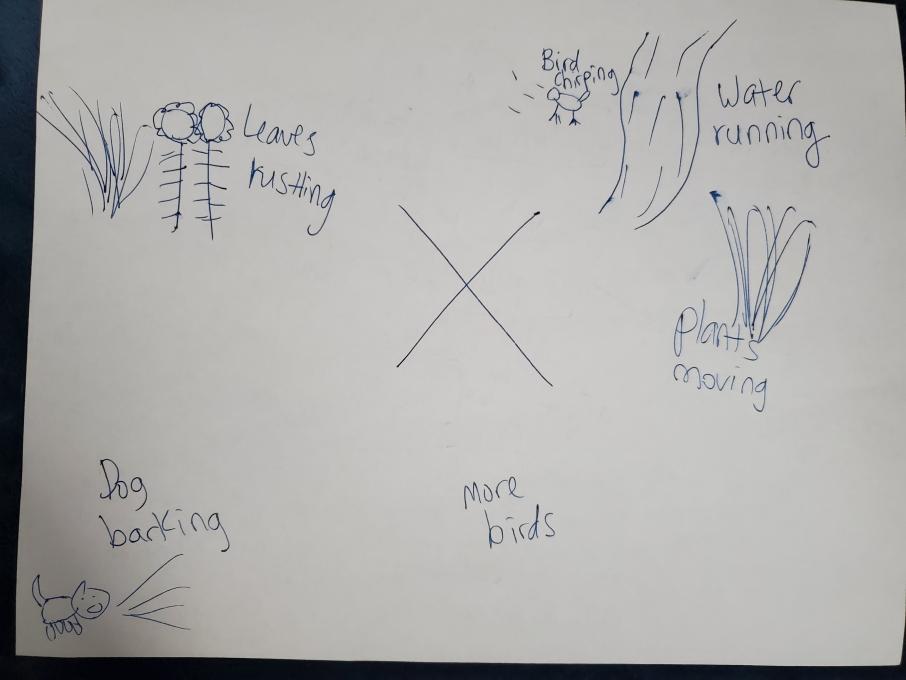
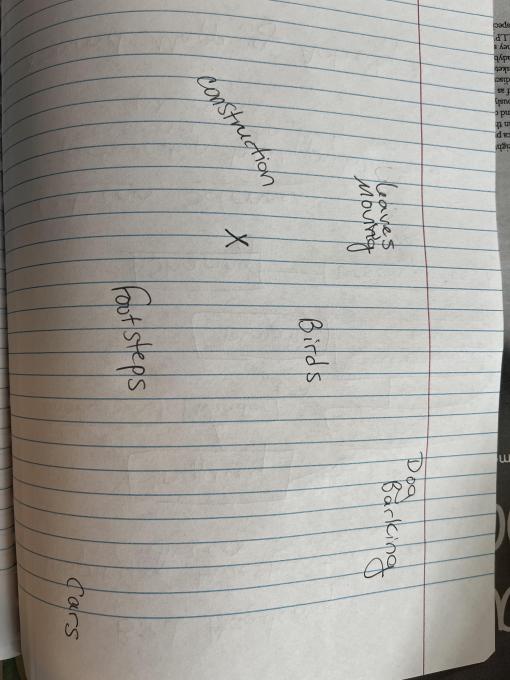


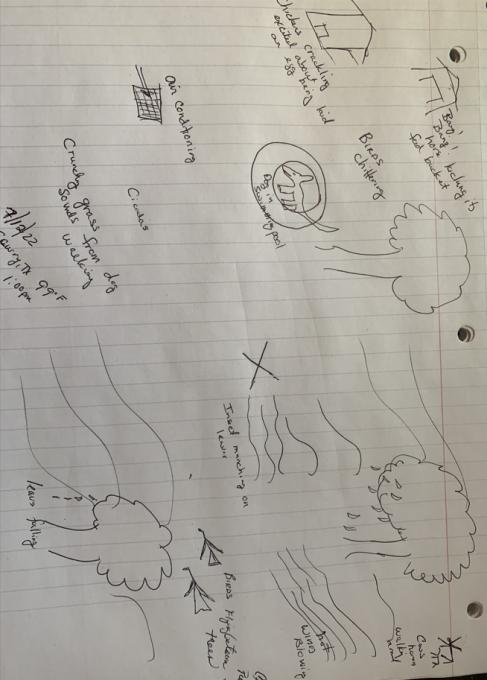 Lots of fun hearing stuff! I do this activity with several of my classes. The little ones we rotate their location 3 times, with 5 minutes at each station. After each station we see how many things they could identify and then move to another station. The more stations we go to the more sounds they notice. This hearing activity is a great way to get kids to explore nature thru all of their senses. One we all enjoy!
Lots of fun hearing stuff! I do this activity with several of my classes. The little ones we rotate their location 3 times, with 5 minutes at each station. After each station we see how many things they could identify and then move to another station. The more stations we go to the more sounds they notice. This hearing activity is a great way to get kids to explore nature thru all of their senses. One we all enjoy! 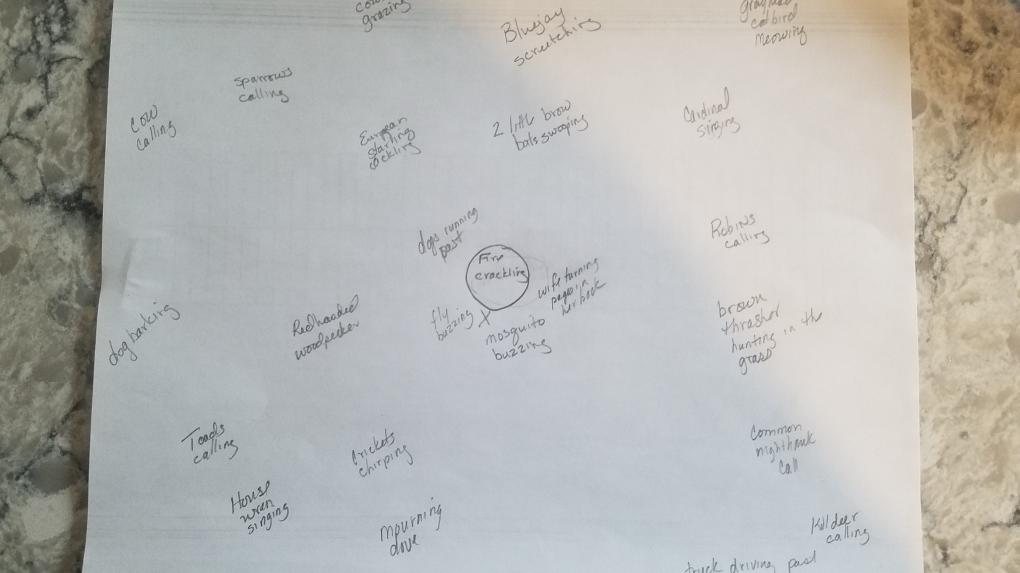
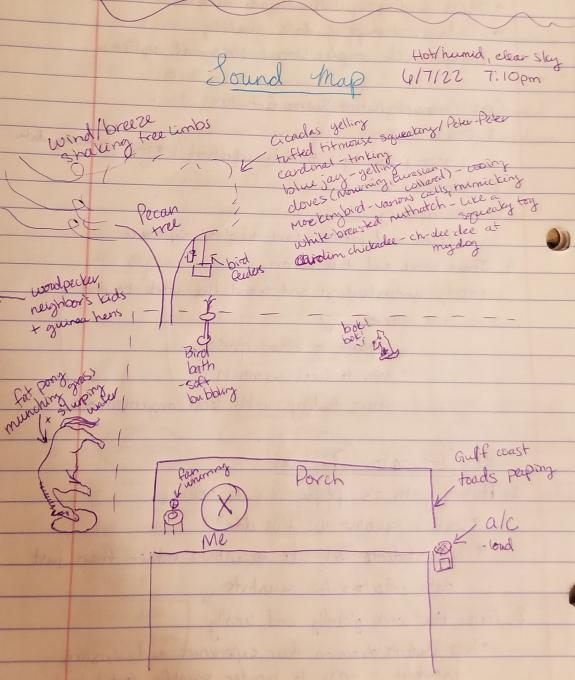 It would be interesting and valuable to sit for a longer period of time and/or at different times of day to compare sounds. I know that during the day I may hear more human sounds like cars or mowers, and at night I would hear more frogs, toads, owls, and chuck-will's-widows. This activity could also be repeated throughout the year, since right now I'm hearing summer sounds of cicadas and the birds that stick around through the summer. In the spring and fall I may hear more variety of migrating birds. These are just the things I expect, but I'm sure if I'm paying close enough attention, I would encounter something unexpected that I never would have noticed without focusing on the sounds!
It would be interesting and valuable to sit for a longer period of time and/or at different times of day to compare sounds. I know that during the day I may hear more human sounds like cars or mowers, and at night I would hear more frogs, toads, owls, and chuck-will's-widows. This activity could also be repeated throughout the year, since right now I'm hearing summer sounds of cicadas and the birds that stick around through the summer. In the spring and fall I may hear more variety of migrating birds. These are just the things I expect, but I'm sure if I'm paying close enough attention, I would encounter something unexpected that I never would have noticed without focusing on the sounds! 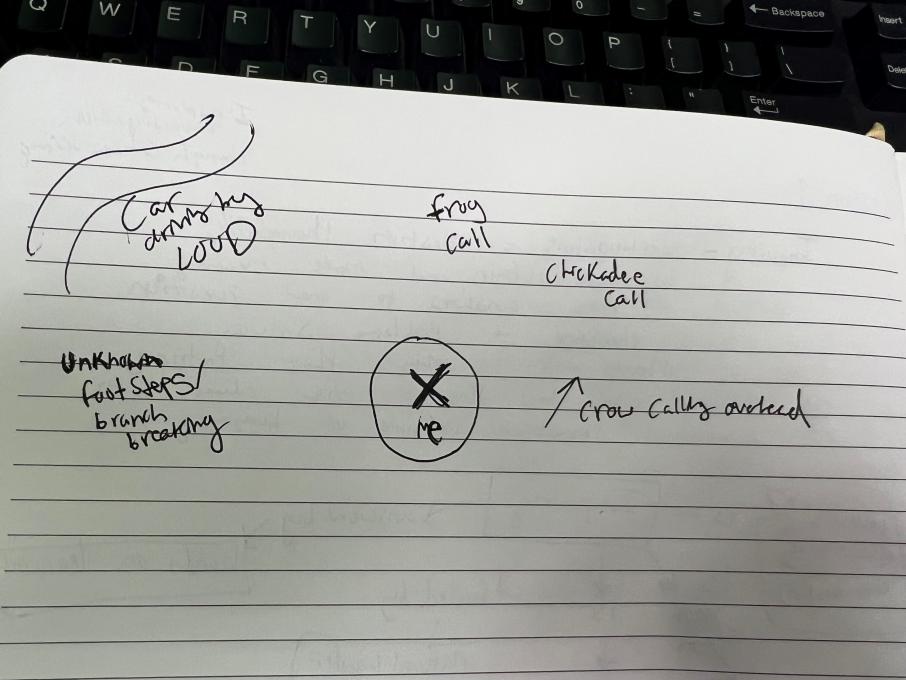
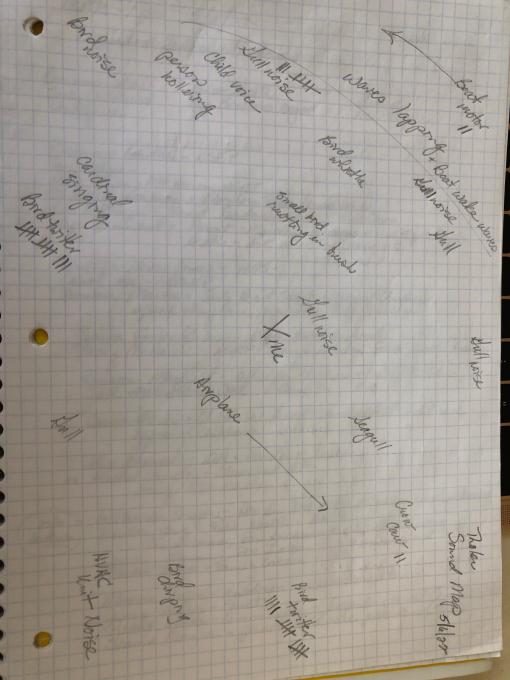
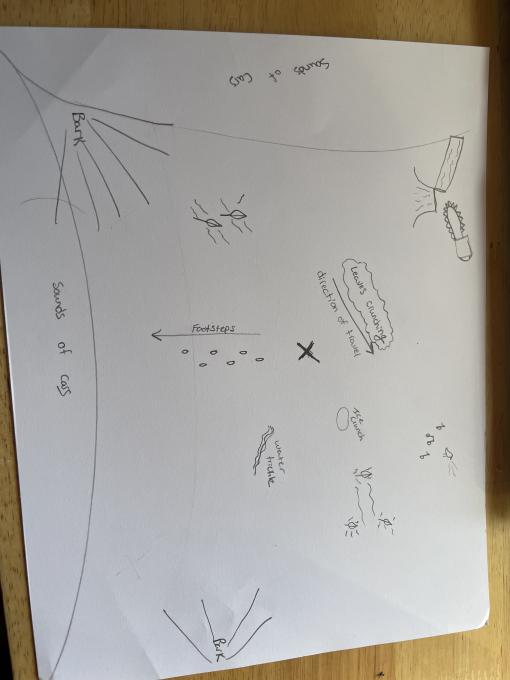
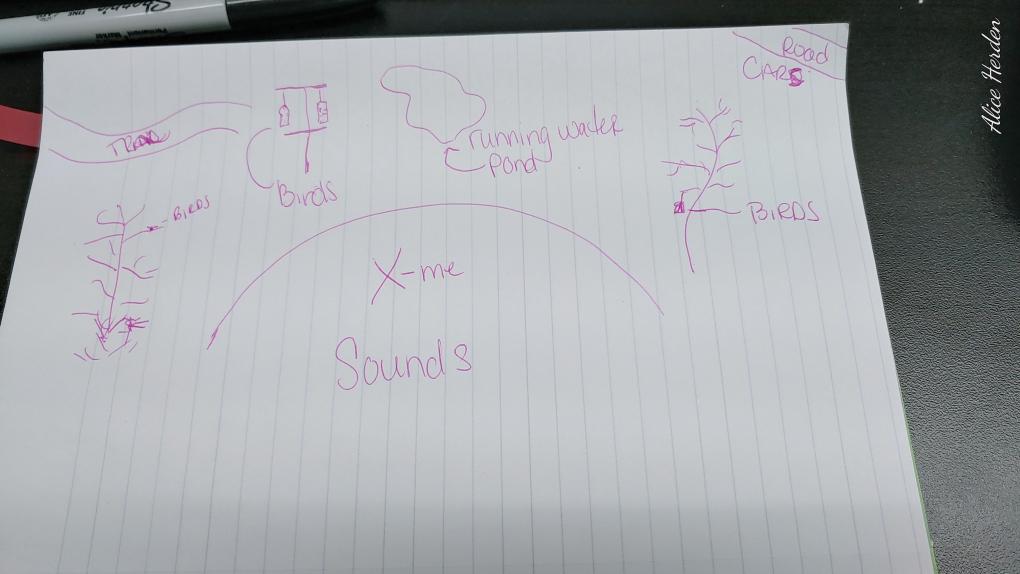
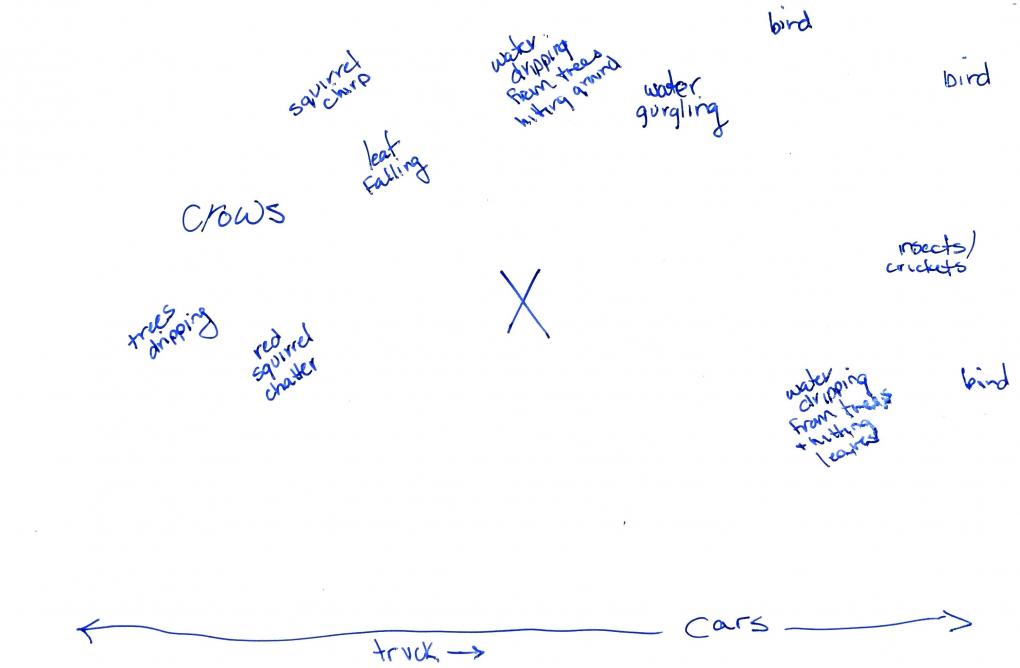
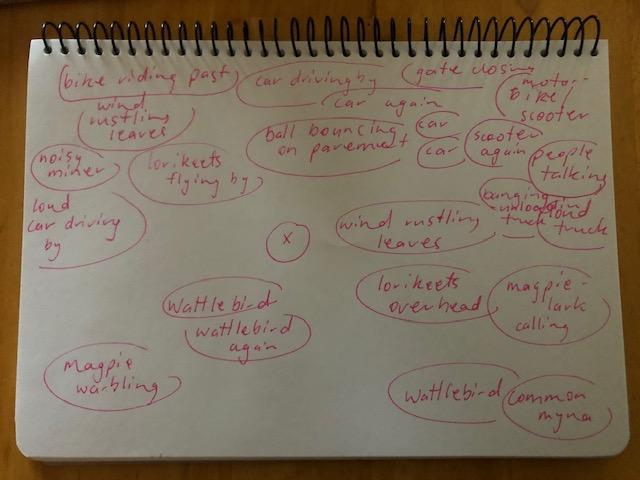
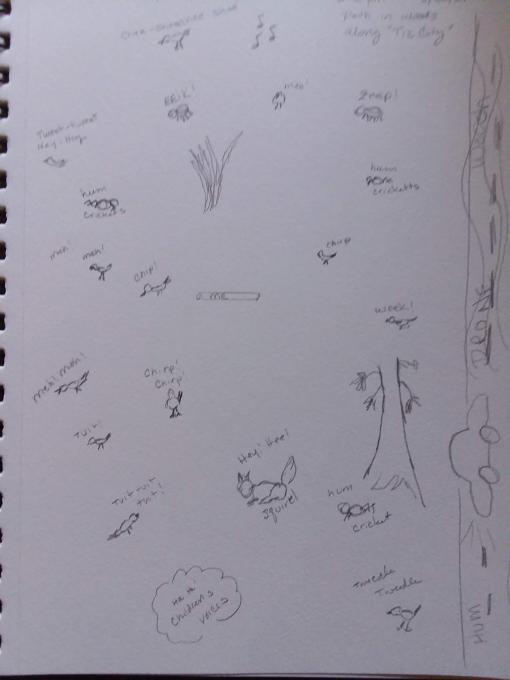 I was amazed by the lack of silence. There was a constant drone of crickets. It was difficult to pinpoint the direction of some sounds. It was hard to capture everything. I was also distracted by mosquitos.
I think this is an activity that would need some direction. Perhaps just tell the students to find a place and record. But then after a certain amount of time have them direct their attention to a section of their listening ability. With sight, we are limited to less than 180 degrees of direction. But with sound, it's 360 degrees, which complicates the ability to record.
However, the "larger range of hearing" opens up more possibilities to observe and note what is going on. Additionally, having students pair up or form small groups can also be helpful in that they can help each other with their observations. Collecting data is not a one-person task and having multiple observers can help gather better data.
I was amazed by the lack of silence. There was a constant drone of crickets. It was difficult to pinpoint the direction of some sounds. It was hard to capture everything. I was also distracted by mosquitos.
I think this is an activity that would need some direction. Perhaps just tell the students to find a place and record. But then after a certain amount of time have them direct their attention to a section of their listening ability. With sight, we are limited to less than 180 degrees of direction. But with sound, it's 360 degrees, which complicates the ability to record.
However, the "larger range of hearing" opens up more possibilities to observe and note what is going on. Additionally, having students pair up or form small groups can also be helpful in that they can help each other with their observations. Collecting data is not a one-person task and having multiple observers can help gather better data. 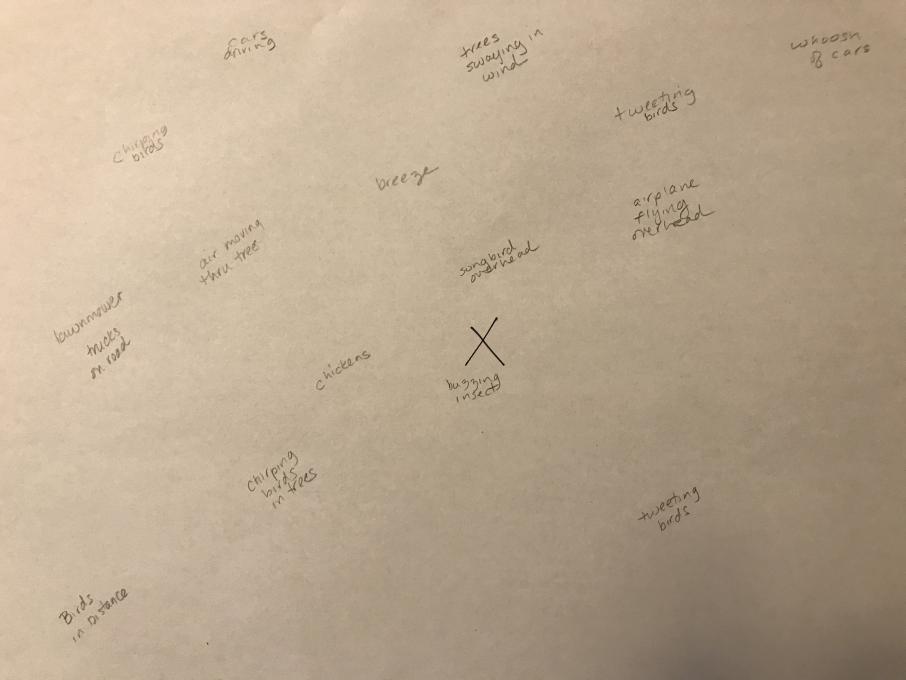
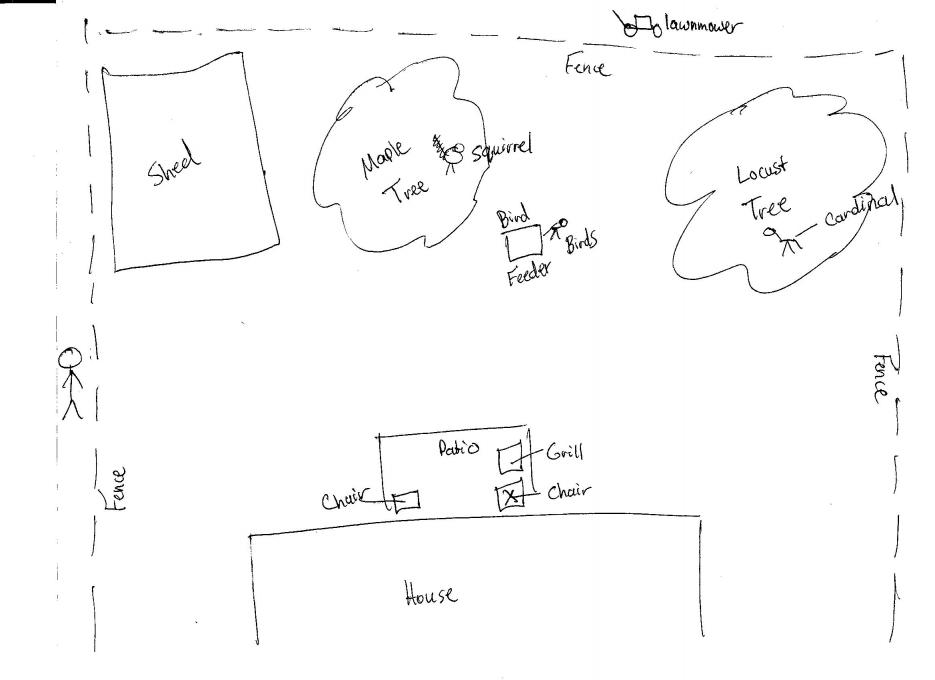
 ir instincts are what will help make them great scientists.
ir instincts are what will help make them great scientists. 